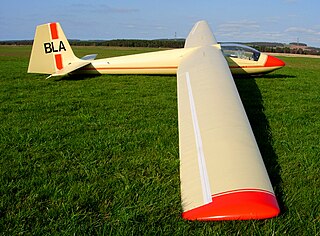
The Slingsby Hengist was a British military glider designed and built by Slingsby Sailplanes Ltd. Like other British troop carrying gliders in the Second World War, it was named after military figures whose name began with H, in this case the Jute invader Hengist.

The Slingsby T.38 Grasshopper is a British primary training glider built by Slingsby Sailplanes for the Royal Air Force.

The General Aircraft GAL.56 was a family of 1940s British experimental tailless swept wing glider designs.

The Slingsby T.41 Skylark 2 was a sailplane produced from 1953 by Slingsby Sailplanes at Kirkbymoorside, Yorkshire.

The Slingsby Type 42 Eagle was a two-seat glider designed in England from 1952.

The Slingsby T.37 Skylark 1 was a small low-cost sailplane built during 1952-3 at Kirbymoorside, Yorkshire by Slingsby Sailplanes.

The Slingsby T.49 Capstan is a British two-seat glider of the 1960s built by Slingsby Sailplanes as a replacement for their earlier Type 42 Eagle.

The Slingsby T.29 Motor Tutor was a single-seat motor glider produced from 1948, by Slingsby Sailplanes in Kirbymoorside, Yorkshire.

The Slingsby T.8 Kirby Tutor was a single-seat sport glider produced from 1937, by Fred Slingsby in Kirbymoorside, Yorkshire.

The Slingsby T.12 Gull was a British single-seat glider designed and built by Slingsby Sailplanes and first flown in 1938.

The SZD-6x Nietoperz was a single-seat tail-less experimental glider aircraft that was designed and built in Poland at Szybowcowy Zakład Doświadczalny in Bielsko-Biała in 1951. Only one example was constructed.

In 1947 a British Gliding Association design competition, for a two-seat sailplane, was won by Hugh Kendall, Miles' assistant test pilot. It was a side-by-side two seater called the Kendall Crabpot I, with a 60 ft. span and an aspect ratio of 18. A version with a novel asbestos fibre-polymer wing and a wooden fuselage with a butterfly tail was proposed by Miles, but the wing failed under low loads. Elliotts of Newbury built a conventional wooden wing to use with Miles' fuselage. The resulting glider flew, but not well and development was abandoned with just one example built.

The Carden–Baynes Auxiliary was the first motor glider with a retractable engine and propeller; it is known as the Abbott–Baynes Scud 3 when engineless. Both aircraft, built in the mid-1930s, were still flying in 2010 as pure sailplanes.

The Slingsby Type 34 Sky is a high performance single seat competition sailplane built in the United Kingdom. It was successful in major events, particularly in the World Gliding Championships of 1952.

The Slingsby T.30 Prefect is a 1948 British modernisation of the 1932 single-seat Grunau Baby glider. About 53 were built for civil and military training purposes.
The General Aircraft GAL.55 was a 1940s British military training glider designed and built by General Aircraft Limited.

The Slingsby Type 45 Swallow was designed as a club sailplane of reasonable performance and price. One of the most successful of Slingsby's gliders in sales terms, over 100 had been built when production was ended by a 1968 factory fire.

The Slingsby T.43 Skylark 3 was a single seat Open Class sailplane developed from the Skylark 2 with an extended wingspan. It won the 1960 World Gliding Championships.

The Slingsby T.50 Skylark 4 was a British single seat competition glider built by Slingsby Sailplanes in the early 1960s. It sold in numbers and had success at national, though not world level competition.

The Abbott-Baynes Scud 2 was a 1930s high-performance sailplane, built in the UK. It was a development of the intermediate-level Scud 1 with a new, high aspect ratio wing.




















